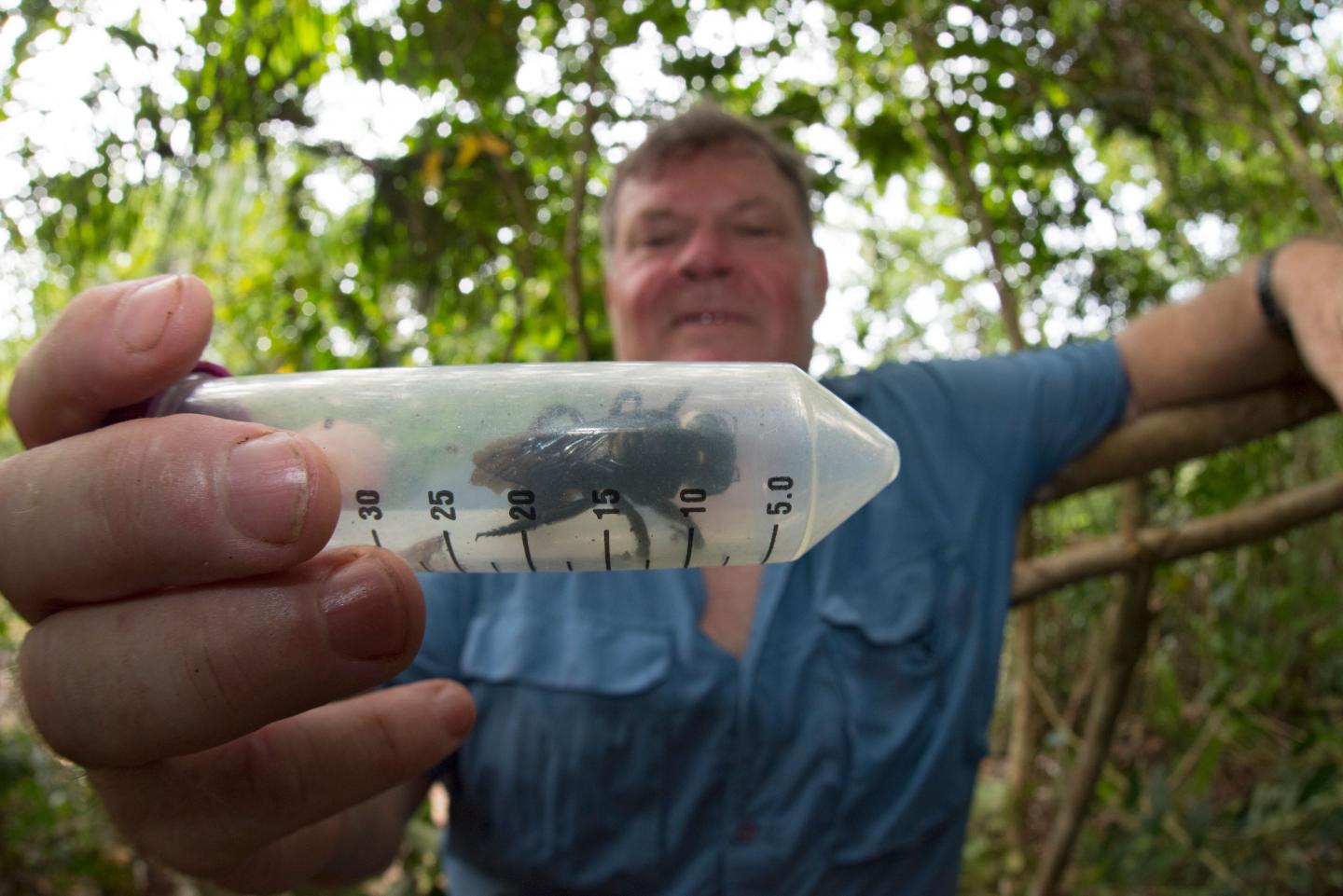Wallace’s giant bee has been rediscovered in Indonesia

Credit: © Clay Bolt : claybolt.com
An international team of scientists and conservationists has announced the finding of what many consider to be the ‘holy grail’ of bee discoveries – Wallace’s giant bee.
The bee (Megachile pluto) is the world’s largest, with a wingspan more than six centimetres (2.5 inches). Despite its conspicuous size, the bee has been lost to science since 1981.
In January, a search team that set out to find and photograph Wallace’s giant bee successfully rediscovered the species in the North Moluccas, an island group in Indonesia. The find resurrects hope that more of the region’s forests still harbour this very rare species.
The discovery was announced today.
A member of the team, Honorary Professor Simon Robson from the School of Life and Environmental Sciences at the University of Sydney, said: “Amid such a well-documented global decline in insect diversity it’s wonderful to discover that this iconic species is still hanging on.”
Dr Robson and Dr Glen Chilton, an honorary professor at Saint Mary’s University in Canada, joined with Eli Wyman from Princeton University and Clay Bolt, a conservation photographer from Montana, to successfully rediscover this bee. The team was supported by Global Wildlife Conservation, an Austin, Texas, based organisation that runs a Search for Lost Species program.
“It was absolutely breathtaking to see this ‘flying bulldog’ of an insect that we weren’t sure existed anymore,” said Clay Bolt, a natural history photographer specialising in bees, who took the first photos and video of the species alive after spending years researching the right habitat with collaborator and team member, Eli Wyman from Princeton University.
“To see how beautiful and big the species is in real life, to hear the sound of its giant wings thrumming as it flew past my head, was just incredible. My dream is to now use this rediscovery to elevate this bee to a symbol of conservation in this part of Indonesia.”
The female giant bee makes her nest in active arboreal termite mounds, using her large mandibles to collect sticky tree resin to line the nest and protect it from invading termites. In hot and humid conditions, and sometimes during torrential downpours, the team observed dozens of termite mounds over the course of the search.
It wasn’t until the last day of a five-day stop in an area of interest that the team found a single female Wallace’s giant bee living in an arboreal termites’ nest in a tree about 2.5 metres off the ground.
The bee is named after Alfred Russel Wallace, the co-discoverer alongside Charles Darwin of the theory of evolution through natural selection. Wallace, a British entomologist, discovered the giant bee exploring the Indonesian island of Bacan. He described the female bee, which is about the length a human thumb, as “a large black wasp-like insect, with immense jaws like a stag-beetle”.
The bee wasn’t seen again until 1981, when entomologist Adam Messer rediscovered it on three Indonesian islands and was able to observe some of its behaviour, including how it uses its mandibles to gather resin and wood for its nests. Since then, other teams have looked for the bee, with no luck.
“Messer’s rediscovery gave us some insight, but we still know next to nothing about this extraordinary insect,” said Mr Wyman. “I hope this rediscovery will spark research that will give us a deeper understanding of this unique bee and inform any future efforts to protect it from extinction.”
Although little is known about the bee, the species depends on primary lowland forest for resin and the nests of tree-dwelling termites, Mr Bolt said. In Indonesia, forest destruction for agriculture, however, threatens the habitat for this species and many others. Between 2001 and 2017, Indonesia lost 15 percent of its tree cover, according to Global Forest Watch.
The team has already started conversations with Indonesian collaborators to look for Wallace’s giant bee in other locations – with the hope of eventually working together to develop a plan to strengthen conservation measures for the bee.
A documentary film, In Search of the Giant Bee is now being produced by Vanessa Dylyn of Matter of Fact Media, in association with Glen Chilton.
###
View a video about the discovery at this link
Photos and video: Wallace’s Giant Bee, lost to science since 1981, is the world’s largest bee. (Photo by Clay Bolt) Download photos and video
Honorary Professor Simon Robson from the School of Life and Environmental Sciences also holds an adjunct professorial position with CQUniversity.
Media enquiries
University of Sydney: Media adviser: Marcus Strom [email protected] +61 423 982 485
Honorary Professor Simon Robson +61 411 160 805
CQUniversity: Jocelyn Sticklen [email protected] +61 418 212 763
Global Wildlife Conservation: Lindsay Renick Mayer [email protected] +1 202 422 4671
Media Contact
Marcus Strom
[email protected]
61-423-982-485
Original Source
https:/




